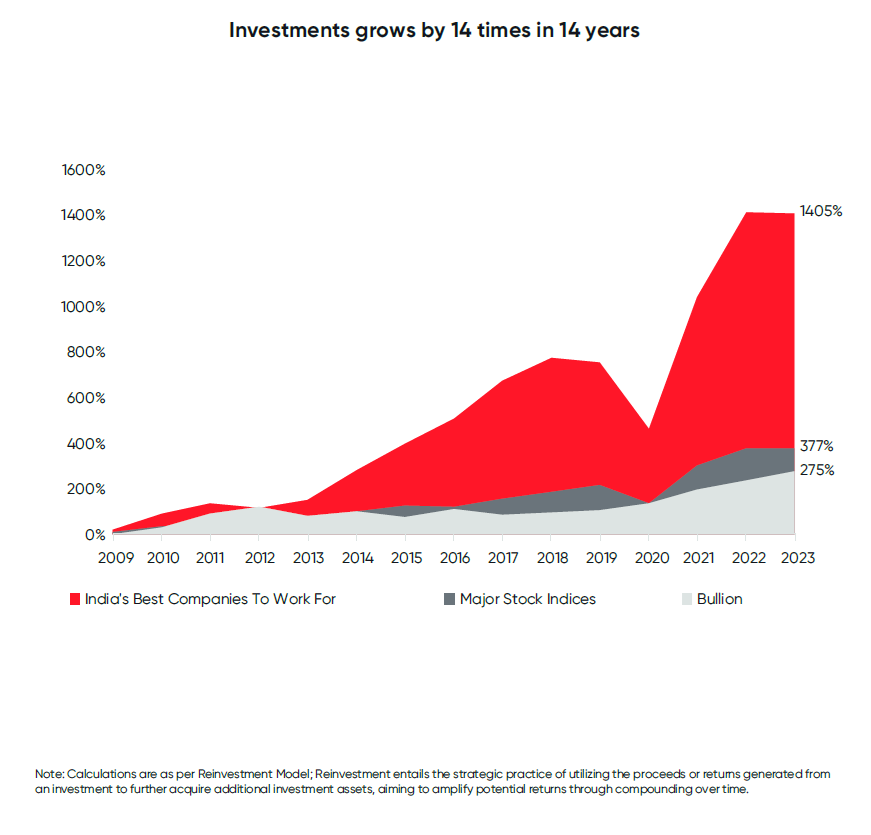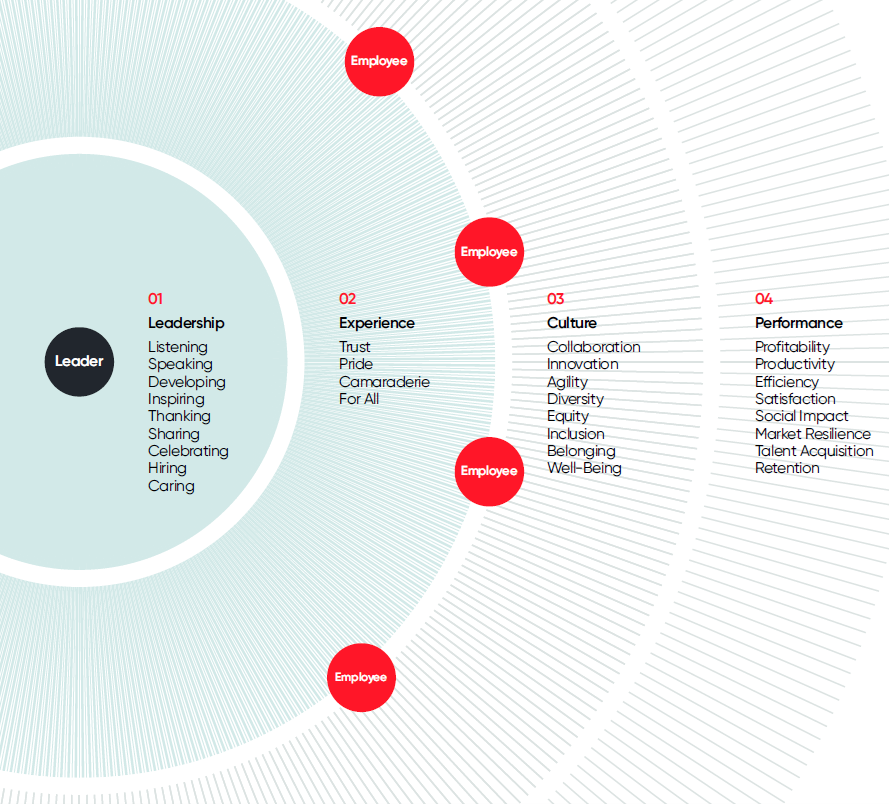Reading Time: 5 minutes
Great workplaces aren’t just good for employees; they’re essential for business growth. When leaders prioritize creating a positive employee experience, it has a ripple effect throughout the organization. Great Place To Work® Certification™ isn’t just a badge of honor; it signifies a commitment to fostering a thriving and agile culture that fuels innovation and performance and attracts top talent.
India’s Most Trusted Leaders understand this. They cultivate environments where employees feel valued, inspired, and empowered to develop their skills. These leaders build trust and camaraderie through open communication, ongoing development opportunities, and genuine appreciation. This not only fuels employee well-being but also sets the stage for success in an AI-driven future where agility and purpose are paramount.
The Competitive Advantage of a Great Workplace Culture

In today’s competitive job market, companies with strong workplace cultures have a significant advantage. They attract and retain top talent, fostering a sense of loyalty and dedication that translates to higher productivity and innovation. Research by Great Place To Work and RSM India shows a clear correlation between a positive employee experience and strong financial performance. Companies recognized as Great Places To Work typically outperform the stock market, demonstrating the tangible benefits of investing in employee well-being and a positive workplace culture.
The Power of High-Trust Culture
Great Place To Work’s research reveals nine key leadership behaviors that create a high-trust culture. Interestingly, these behaviors aren’t limited to those at the top. While leaders play a crucial role in shaping the employee experience, everyday interactions and collaboration throughout the organization are equally important. Building a truly great workplace requires a collective effort.
The 9 High-Trust Behaviors for High-Performing Culture

- Active Listening: Great leaders solicit feedback, actively listen to their team’s concerns and ideas, and value their input by incorporating it into decision-making. This demonstrates respect and fosters a sense of psychological safety, where employees feel comfortable sharing their perspectives without fear of reprisal.
- Open Communication: Transparency and clear communication are key. Leaders should keep everyone informed about important developments and encourage a two-way flow of information. Regular town halls, Q&A sessions, and internal communication platforms can facilitate open communication and build trust.
- Inspiring Vision: Leaders who share the company’s vision and mission with passion are contagious. They lead by example, demonstrating enthusiasm for the work and its impact. Inspiring leaders connect individual contributions to the bigger picture, motivating employees through stories of success and the positive impact of their work.
- Genuine Care: Showing genuine concern for your team’s well-being builds trust and loyalty. Offer support during challenging times, promote work-life balance, and be flexible when necessary. This demonstrates that the company values its employees as people, not just cogs in a machine.
- The Power of Appreciation: Regularly acknowledge your team’s hard work and contributions. Personalized thank-you notes, public recognition programs, and small rewards can significantly boost morale. Feeling valued and appreciated is a key driver of employee engagement and satisfaction.
- Investing in Growth: Leaders who prioritize professional development opportunities empower their teams. Provide training, mentorship, and challenging projects to foster continuous learning and support career advancement. Investing in employee development shows a commitment to their long-term success within the company.
- Hiring for Culture Fit: Hiring individuals whose values align with the organization’s culture is crucial. Conduct thorough interviews to assess both skills and cultural fit. When employees share the company’s values, it fosters a sense of belonging and collaboration.
- Celebrating Success – Big and Small: Take the time to celebrate milestones and achievements, both big and small. Organize team-building activities, social events, and recognition ceremonies to build camaraderie and a sense of accomplishment. Celebrating successes reinforces positive behaviors and motivates teams to achieve even greater things.
- Promoting Fairness: Ensure equitable distribution of profits, compensation, bonuses, and resources. This fosters a sense of inclusion and belonging. When employees feel like they are treated fairly, it builds trust and loyalty towards the organization.
Leading by Example: Building Trust Through Action
Rahul Agrawal, CEO of Barbeque-Nation Hospitality Limited, exemplifies trust-based leadership. His people-centric approach, built on transparency and strong interpersonal relationships, fosters a stark contrast to the transactional nature of finance. This philosophy translates to stability and performance, especially during times of market uncertainty or corporate change. As Mr. Agrawal says, “Leadership is about creating an environment where trust and transparency guide our actions, ensuring our core values and relationships drive our collective success.”
Balakrishna Navuluri, COO of YASH Technologies Private Limited, embodies leadership defined by empathy and empowerment. He actively engages with employees at all levels, ensuring their voices are heard and concerns addressed. This commitment to open communication and personal connection forms the foundation of his leadership style. Mr. Navuluri emphasizes, “To drive innovation, especially in the evolving world of technology, the top three priorities are simple: learn, learn, and learn. Mastering the application of technology is not just a goal; it’s our key to unlocking potential, to solving problems we haven’t yet encountered, and creating opportunities that will shape our future.”
Building a Great Place To Work: A Journey, Not a Destination
Creating a great workplace is an ongoing process, but the benefits are undeniable. By implementing these high-trust behaviors, leaders can create a work environment where employees feel valued, empowered, and inspired to do their best work. This translates to a more engaged workforce, higher productivity, and, ultimately, a thriving and successful organization.
The Road to Greatness: Getting Started
Here are some initial steps your organization can take on the journey to becoming a Great Place To Work:
- Conduct an Employee Survey: Understanding your employees’ perspectives is crucial. Great Place To Work offers a validated employee experience survey tool that can provide valuable insights into employee satisfaction and areas for improvement.
- Define Your Core Values: Clearly defined core values serve as a compass for your organization, guiding decision-making and behavior. Involve employees in the process of defining your core values to foster ownership and alignment.
- Develop a Recognition and Rewards Program: A well-designed program shows appreciation for employee contributions and reinforces desired behaviors. The program should be flexible and cater to diverse preferences.
- Promote Work-Life Balance: Offer flexible work arrangements, encourage breaks, and create a culture that prioritizes employee well-being outside of work.
- Empower Employees: Give employees ownership of their work and provide opportunities for them to make decisions. This fosters a sense of responsibility and accountability, leading to higher engagement.
Conclusion: Building a Great Place To Work is an Investment in Your Future
Investing in creating a Great Place To Work is an investment in the future of your organization. By fostering a positive employee experience, you can unlock the full potential of your workforce, achieve greater innovation, and secure a competitive advantage in the years to come. Great Place To Work Certification provides a valuable framework and resources to guide you on this journey.
Embark on your journey to becoming a Great Place To Work today!





